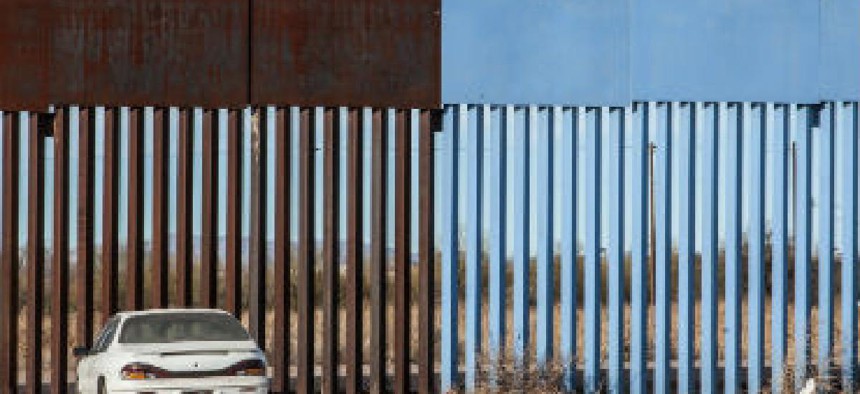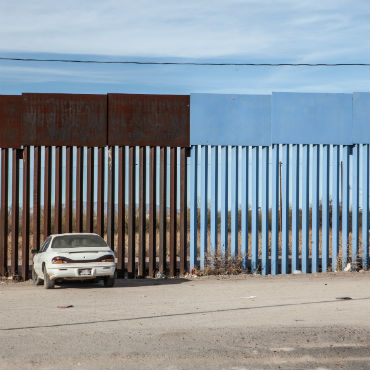Border wall won't span sea to sea

DHS chief John Kelly paints a clearer picture of the developing border barrier project, which includes a mix of walls, technology and fencing.

A section of U.S.-Mexico border fence as seen from the Mexico side, looking into Douglas, Ariz. (Photo credit: Chess Ocampo / Shutterstock.com)
The border wall under development by the Department of Homeland Security will not be a monolithic concrete wall spanning the length of the southern U.S. border but will mix a variety of technologies, the agency's leader told a Senate hearing.
"It is unlikely that we will build a wall, a physical barrier, from sea to shining sea," said DHS Secretary John Kelly in a Senate Homeland Security and Governmental Affairs committee hearing on improving border security and public safety.
DHS will give its border agents technology that will work more effectively for their sectors, depending on their needs and requests, he said.
"Physical barriers work," Kelly asserted, but he said in talking with Customs and Border Protection managers on the ground, he heard from them that physical barriers may not work in some areas along the rugged landscape along the southern border. Kelly’s remarks backed up his assertion in his January confirmation hearing that a physical barrier alone "wouldn't be adequate."
"We won't build a wall where it doesn't make sense," he said during the April 5 hearing, adding that the physical makeup of the project was still coalescing. Later in the hearing, Sen. Jon Tester, (D-Mont.) asked about how an initial $20 million for the wall project would be spent. "If it's being used to put up a concrete wall, we will know how this is going," adding that splitting up the money for a wall prototype and technology such as radar and ground sensors would "put us more at ease."
"I'm not going to build one prototype. We'll take a look at what makes sense," Kelly responded.
Kelly was questioned repeatedly on many issues -- from the border barriers, vetting of foreign travelers' cell phones and drug interdiction -- during the hearing.
Moving ahead, he told the panel that locations for border wall sections would be primarily directed by CBP sector chiefs who can determine where such structures would be most effective and where technology and/or fencing would work best.
Walls, he said, will probably be most effective where they can deflect migrant traffic away from cities on the U.S. side. "Coyotes [human traffickers] aim for cities" where migrants can disappear more readily into the U.S., he told the committee.
In rugged or less-traveled areas where fencing or a solid wall are impractical, technology such as advanced detection and surveillance systems, tethered and tactical aerostats, unmanned aircraft systems and ground sensors will all play a role in an intermixed physical/technological barrier, Kelly said in his written testimony.
The requests for proposals for prototypes of the physical barrier did not include much detail on technology, something that didn't escape committee's notice.
"The prototype has no technology," said Ranking Member Sen. Claire McCaskill (D-Mo.) Technology, she said, can provide critical data to agents manning walls and fencing. "Situational awareness is key," she said. Including technology and fencing as options in the program, she added, will go a long way with getting congressional approval for it.
In his written testimony, Kelly said the White House will request the next increment of border wall funding in the fiscal 2018 budget. The FY 2018 Budget Blueprint, released Feb. 16th, sought $2.6 billion for high-priority border security technology and tactical infrastructure, including funding to plan, design and construct the border wall. More details will come in mid-May, Kelly pledged, but the money will be used to make "sizable investments" in new border barriers, fencing, roads as well as "security technology and equipment in the highest risk areas of operation."
President Donald Trump has vowed to build a physical wall along the border with Mexico from the early days of his presidential campaign.
"Is the president okay with fencing?" McCaskill asked.
"The president said 'Kelly go do it.' I have elbow room," to include technology and barriers other than just a concrete wall, he said.
Kelly will get some help with his workload on the wall and other issues from his newly confirmed Deputy Secretary Elaine Dukes. The Senate approved her nomination on April 5. Duke was grilled on wall costs by the Democratic members of the same committee in early March during her confirmation hearing.


